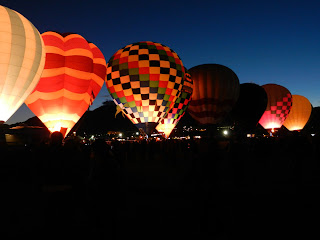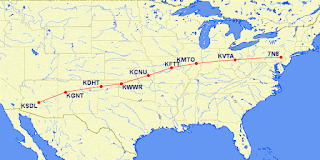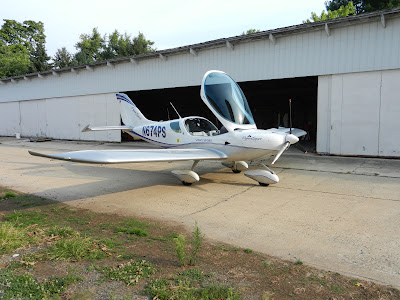All too soon it was time to leave. Nate drove me out to the airport early Sunday morning. We finished packing Sally, went into the FBO to settle our account (Landmark Aviation had been a superb host) and sat at the computer for flight planning. Lockheed didn't tell me anything I didn't already know, no TFRs, no significant weather, no important NOTAMS to worry about. Once more around the plane and Nate and I made our goodbyes and I buckled in. I pushed the Trip button after a smooth start, called ground and taxied out. Sally and I thanked KSDL for their hospitality and departed to the east.
 |
| Final packing before departing KSDL |
I climbed to 7500' but quickly realized that wouldn't cut it. After awhile we climbed to 9500' to clear a range of mountains and soon after ATC asked us to go up to 11,500' to stay in radar coverage. Slight quartering tailwinds didn't help us much but the skies were clear and the view was gorgeous. I had chosen a southern route to take advantage of the valleys and more favorable terrain. Just a few peaks were still above us and it was easy to choose a course around them. Before too long the first fuel stop came into view with winds down the runway at 22 kts. Funny how that now seemed relatively mild.
 |
| South east to EWM over to WHOLE to avoid White Sands |
Topped her off, stretched my legs and climbed back in. Soon we were heading east again and as I climbed to 7500' I called for Flight Following. White Sands was active, what were my intentions? I love my 696. I wasn't going over it, too far to divert to the north, so I said I would stay south. He offered some way points at EVM and WHOLE to keep me clear so I plugged them into the flight plan. I told him I would fly the route as advised, pushed the autopilot buttons and settled in. We were getting beat up at this altitude so once again I asked for and received clearance (maintain VFR) for 9500'. Still turbulent but a little more comfortable but too much for Sally. I clicked off altitude hold and hand flew. Soon I got a DSAB error telling me we were not linked to the GPS. I switched to heading mode and made minor corrections to stay on course. With nothing else to do I tried DSAB reconfiguration which would work for awhile but fail time and again.
It was about noon when I hit my head on the canopy. The ridge really didn't look to be all that impressive. The chart said the peaks were less than 4500', but with convective heating and gusty winds the effect on Sally was major. A few more bumps and we were clear, and my heart went back to a normal rhythm.
My fuel calculations were looking good. I would need to make one stop before KADS instead of two. So I started checking weather and decided to make the one coming up and skip the next. (IF things changed I could always add it back in.) Winds at 26 kts this time...that had my attention. As I turned on final I felt like Sally stopped. Our roll-out was probably ten feet, and I was very cautious with the taxi over to the FBO, making sure I didn't get a wing lifted by the stiff breeze. I chose full service this time. This place was under major repair. Cabinets were pulled off of the walls, the desk was in the middle of the floor and stacks of sheet rock were lined up in the hallway to the rest rooms. The temporary Sunday afternoon help took awhile to figure out the credit card machine, but the price was good so no complaints.
Eastbound again and enjoying some 20kt tailwinds at 5500'. We would definitely make Addison without additional fuels stops. Heading east you lose daylight. We would reach our destination after dark. This could get interesting. I played with the DSAB and found that after doing a reconfiguration and resetting the autopilot power switch my error went away. I flew the next hour or so without any problems.
I like flying at night. I just don't get to do it very often because my home field really doesn't have a good light system. After the sun goes down the air get calm and other airplanes become much easier to see. Airports are usually easier to see as well due to their lights and beacons. Sally's instrument lighting is great. The Dynons auto-adjust and the 696 is easy to dim for low light conditions. I pulled a flashlight out of my bag, checked it and sat on it. I was ready.
ATC handed me over to regional control, and I made a step down descent to 2000' to stay beneath the Class B shelf. I was told to continue east until past the dam, then turn onto the final approach course and announce any changes in altitude. What dam? The 696 showed a dark spot to the east and seeing no lights I assumed it was a reservoir. The 696 provides runway extensions so turning on course was easy. I left the autopilot on and let Sally hold altitude while I used the heading knob to make turns. Regional Control was very busy and decided to give me a box to fly to get me out of the way for faster traffic...a Cessna Citation.
Back on course he thanked me for my cooperation and told me to let him know when I had the field in sight. Eh, 7 miles out and I don't see it. Lot's of city lights but nothing I can identify as an airport! Patience. The first thing I saw was the beacon, then the beautiful threshold lights. A great landing followed. A short taxi over to US Sport Aircraft and we were done for the night. What a GREAT ride! (I would later find out, after talking to other pilots, that KADS is notoriously hard to find at night.)
Patrick made wonderful arrangements for me. I'll talk about the fantastic service in another post, but suffice to say Sally is like a new airplane. The new prop is wonderful and she really runs...smooth. I am delighted.
We departed Wednesday late in the morning ...weather. I enjoyed executing the ground procedures and getting Flight Following set up before taxi. Once airborne I was forced to stay at 2000' feet until I cleared the traffic area, then found a hole in the broken layer and climbed up to 5500' on top. She sounds different. I can't hear the RPM changes like before so have to pay a bit more attention to the tachometer when leveling off. She is about 5kts faster and she is ....smooth. I feel a difference but don't know another way to say it. Smooth.
After two hours I was feeling the fatigue so decided to make KARG my overnight stop. Walnut Ridge is an old WW2 training base that has gone through a number of evolutions to become a GA airport. The runways are gigantic and at one time serviced 747's. (One reason I chose this during my planning was a NOTAM stating 747s can't land here...what's up with that?) Just as I prepared to make my position call the batteries in my headset failed. That gets your attention. I cannibalized my flashlight and was soon back to Active Noise Cancelling.
I was given the crew van, directed to the Days Inn in Pocahontas. They honored my military discount and were helpful with directions for an evening meal, but as I drove down the road I spotted a Sonic! Pocahontas has a SONIC! Worked for me.
 |
| Sporty's |
An 8:00am start with a climb to 3500' under an overcast. Soon I found a hole and climbed on top to level at 7500'. Smooth sailing into Clermont County (I69) and a visit to Sporty's. It's OK, just OK. The catalog has much more stuff in it. After buying my stuff in Addison, there really wasn't any temptation to open my wallet again. I grabbed an ice cream sandwich out of a vending machine and sat down to do some planning. Three hours from home but KPTW was IFR. A call home confirmed low ceilings and light rain so I planned for an alternate at KUNV.
Smooth air at 5500' and no obvious clue that weather in eastern Pennsylvania was lousy. Permission to pass through the Pittsburgh Class B shortened my trip into University Park and I landed well before dark. Great service by the FBO. I caught the shuttle to the Holiday Inn Express, the aviation discount a few dollars better than my discount. I got a (well deserved) rib eye at the nearby Outback.
Friday I woke up to fog. Dense ugly fog. The weather briefer was optimistic for the afternoon so I had a good hotel breakfast (biscuits and gravy) and waited for awhile before going back to the FBO. I watched the low ceilings as the shuttle took me back to the airport. Light winds and good visibility, but the clouds hung low over the mountains. The briefer called it 'Mountain Obscuration", which really meant 'forget about it'. He expected improvement by 2:00.
At 1:30 I did what turned out to be a test flight.A few miles from the airport the clouds reached down and hid the mountain ridge to the left, and light rains veiled the ridge to the right. I did a "RTB" to wait for better conditions.
At 3:00 I tried again, and this time was able to avoid the trouble spots and get safely home. A nice landing at Butter Valley, I checked the trip time at 20:56*. What an adventure.
 |
| 2,204 miles |
* A check flight was done at KADS to check on all maintenance (0.5). I did a weather check flight at KUNV (0.6).















































